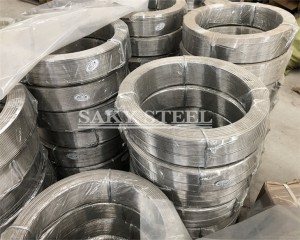Four Types of Stainless Steel and the Role of Alloying Elements:
Stainless steel can be classified into four main types: austenitic, martensitic, ferritic, and duplex stainless steel (Table 1). This classification is based on the microstructure of stainless steel at room temperature. When low-carbon steel is heated to 1550°C, its microstructure changes from room-temperature ferrite to austenite. Upon cooling, the microstructure reverts to ferrite. Austenite, which exists at high temperatures, is non-magnetic and generally has lower strength but better ductility compared to room-temperature ferrite.
When the chromium (Cr) content in steel exceeds 16%, the room-temperature microstructure becomes fixed in the ferrite phase, maintaining ferrite at all temperature ranges. This type is referred to as ferritic stainless steel. When both the chromium (Cr) content is above 17% and the nickel (Ni) content is above 7%, the austenite phase becomes stable, maintaining austenite from low temperatures up to the melting point.
Austenitic stainless steel is typically referred to as “Cr-N” type, while martensitic and ferritic stainless steels are directly called “Cr” type. Elements in stainless steel and filler metals can be categorized into austenite-forming elements and ferrite-forming elements. The primary austenite-forming elements include Ni, C, Mn, and N, while the primary ferrite-forming elements include Cr, Si, Mo, and Nb. Adjusting the content of these elements can control the proportion of ferrite in the weld joint.
Austenitic stainless steel, especially when containing less than 5% nitrogen (N), is easier to weld and offers better welding quality compared to stainless steels with lower N content. Austenitic stainless steel weld joints exhibit good strength and ductility, often eliminating the need for pre-welding and post-welding heat treatments. In the field of stainless steel welding, austenitic stainless steel accounts for 80% of all stainless steel usage, making it the primary focus of this article.
How to choose the correct stainless steel welding consumables, wires and electrodes?
If the parent material is the same, the first rule is to “match the parent material.” For example, if coal is connected to 310 or 316 stainless steel, choose the corresponding coal material. When welding dissimilar materials, follow the guideline of selecting a base material that matches a high alloying element content. For example, when welding 304 and 316 stainless steel, choose 316 type welding consumables. However, there are also many special cases where the principle of “matching the base metal” is not followed. In this scenario, it’s advisable to “refer to the welding consumable selection chart.”. For example, type 304 stainless steel is the most common base material, but there is no type 304 welding rod.
If the welding material needs to match the base metal, how to choose the welding material to weld 304 stainless steel wire and electrode?
When welding 304 stainless steel, use type 308 welding consumables because the extra elements in 308 stainless steel can better stabilize the weld area. The 308L is also an acceptable choice. L indicates low carbon content, 3XXL stainless steel indicates a carbon content of 0.03%, while standard 3XX stainless steel can contain up to 0.08% carbon content. Since L-type welding consumables belong to the same type of classification as non-L-type welding consumables, manufacturers should consider using L-type welding consumables separately because its low carbon content can reduce the tendency of intergranular corrosion. In fact, the author believes that if manufacturers want to upgrade their products, L-shaped yellow materials will be more widely used. Manufacturers that use GMAW welding methods are also considering using 3XXSi type stainless steel because SI can improve wetting and leakage parts. In the case where the coal piece has a higher peak or the welding pool connection is poor at the weld toe of the angle slow seam or lap weld, the use of gas shielded welding wire containing S can moisten the coal seam and improve the deposition rate.
Post time: Sep-26-2023
